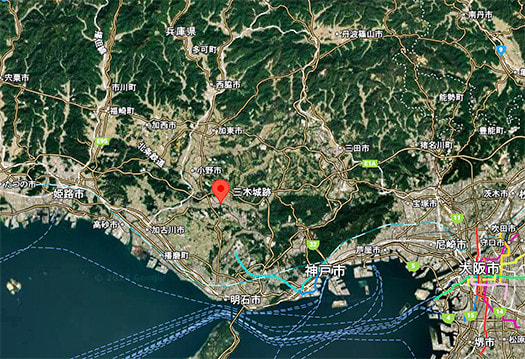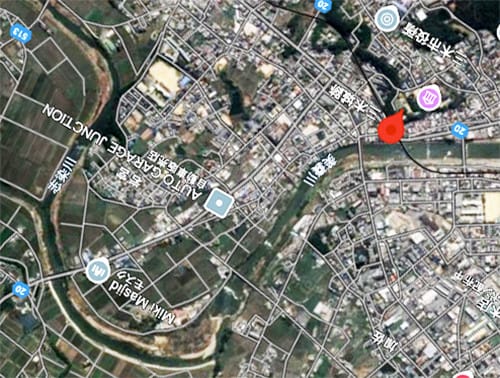
さてアメリカ大統領選は時差の関係もあり、帰趨の情報はまだ発信されてこない。そういうことなので、ブログ記事としては代わりに、いまなにかと話題になっている「兵庫県」で縁の深い「三木城跡」についての探訪記であります。時空をはるかに超えて、合戦・政治闘争についてのつながりか?ムリヤリ感満載であります(笑)。
現代でも斉藤前知事の失職以降の出直し知事選さなかで、NHK党(いまはどういう名前か知らない)の立花氏が立候補して前知事の「無実」を訴えているとのこと。なにやら「新事実」が浮かび上がってきているとされている。もしそれが真実であるなら、形勢一変であり注目される。
・・・ということですが、本日はその兵庫県のほぼ中央部の三木市に残る「三木城跡」のこと。わたしの姓が冠されていて、家系伝承でもなにかとクロスする地名・氏名(うじめい)であります。司馬遼太郎さんの記述では、兵庫県では1870年(明治3年)9月19日、すべての国民が苗字を持つことを許された時には、「おれ、三木」「オレも三木」と多数の方々がこの三木城関連の素性であると名乗り出られたという説。全国有数の「三木家」多数派地域であります。郷土への愛のひとつの共有体験として織田・秀吉軍による攻撃と城主・別所氏の決断によって城明け渡し・城主の自害・城兵の助命が大きく残像が残っていたということでしょうか。
この三木城というのは、経済の伝統的要衝地に立地。京都からの西国への主要な街道筋を押さえる位置にあって、戦国当時もその利権を狙って山陰の戦国大名「尼子氏」に攻撃されたり、京都を押さえた三好氏にも攻撃されている。その都度、堅固に城を守り抜いていた。三木市ではいまも「金物」が名産とされているように、京大阪の需要地から交通至便ということもあって、いわば播州における経済のひとつの中心地域だったのだと思われます。神戸は明治以降、国際貿易港として経済活動がさかんになっていくけれど、それ以前には三木城が播州のひとつの中心地だったと思える。


地図は「みき歴史資料館」所蔵の播州三木古城図と、その方向感をそろえてみた現代のGoogleマップ。城の南側の後背地には山地が迫り、北側の前面には美嚢川の流れがあって、補給の機能も備えている条件。高齢期になってきて、播州には時折訪れることが増えてきています。そのたびにふとした機縁にめぐり会わされて、血脈のなつかしさ、歴史を感じることが多いのであります。故地を遠く離れた北海道人にとって日本民族としての素性確認機会とでも言えるのでしょうか?
English version⬇
The Oda and Hideyoshi military units and Miki Castle at the end of the Warring States period
The development of Kobe, an international trading port, has been attracting attention, but the history of Kobe up to the Edo period shows a completely different economic trace in Miki Castle in the central part of Hyogo Prefecture. ...
Due to the time difference in the U.S. presidential election, information on the outcome of the election has not yet been released. Therefore, instead, this blog entry is about a visit to the ruins of Miki Castle, which is closely related to the much talked about “Hyogo Prefecture”. Is there a connection between the two places, or is it about battles and political struggles that transcend time and space? It is full of a sense of unreasonableness (laugh).
Even today, in the midst of the gubernatorial rerun election after former Governor Saito lost his post, Mr. Tachibana of the NHK Party (I don't know what it is called now) is running for governor, appealing for the former governor's “innocence. It is said that some “new facts” have emerged. If it is true, it would be a game changer and attract a lot of attention.
Today, I would like to talk about the ruins of Miki Castle in Miki City, located in the center of Hyogo Prefecture. It bears my family name, and is a place name and name that crosses over into family lore in some way. According to Ryotaro Shiba's account, on September 19, 1870 (Meiji 3), when all people in Hyogo Prefecture were allowed to have surnames, many people came forward saying, “I, Miki,” or “I, Miki,” as if they were related to this Miki Castle. This is one of the areas in Japan where the “Miki family” is in the majority. The attack by Oda and Hideyoshi forces and the decision by the castle's owner, Bessho, to surrender the castle, the owner's suicide, and the lives of the castle's soldiers were all left behind as a shared experience of love for one's hometown.
Miki Castle was located in a traditional economic center. It was located on a major highway from Kyoto to the western part of the country, and was attacked by the Amago clan, a feudal lord in the San'in region, who wanted to take advantage of its location, and by the Miyoshi clan, which held Kyoto. Each time, the castle was firmly defended. As “hardware” is still a specialty of Miki City, it was one of the economic centers in Banshu, so to speak, because of its convenient transportation from the demand areas of Kyoto and Osaka. Kobe became an international trading port after the Meiji period (1868-1912), but before that, Miki Castle seemed to be the center of Banshu.
The map is a modern Google map that attempts to align the sense of direction with the old castle map of Banshu Miki in the collection of the Miki Historical Museum. The southern hinterland of the castle is looming in the mountains, and the northern front has the flow of the Mishu River, a condition that also serves the function of supply. In my advanced age, I have been visiting Banshu more and more from time to time. Each time I visit Banshu, I am often struck by a chance encounter and feel the nostalgia and history of my bloodline. For the people of Hokkaido, far away from their homeland, it is an opportunity to confirm their identity as Japanese people.




























※コメント投稿者のブログIDはブログ作成者のみに通知されます